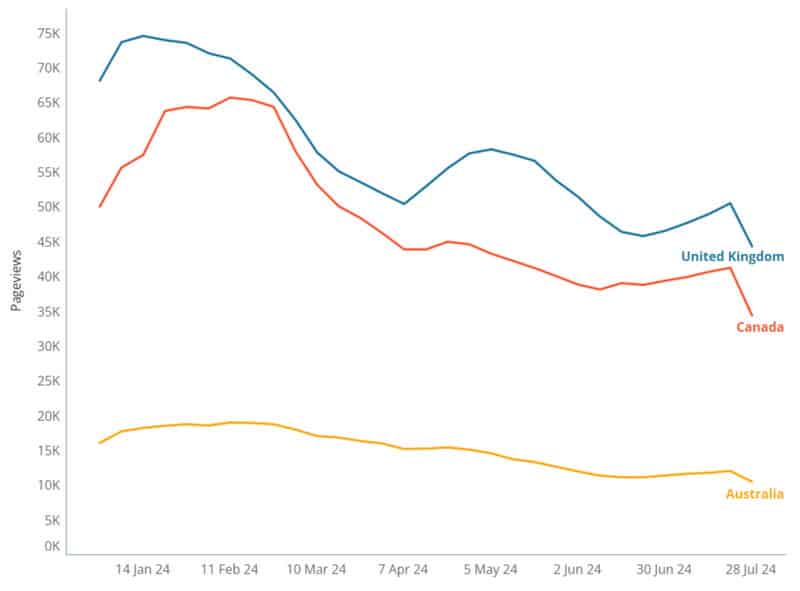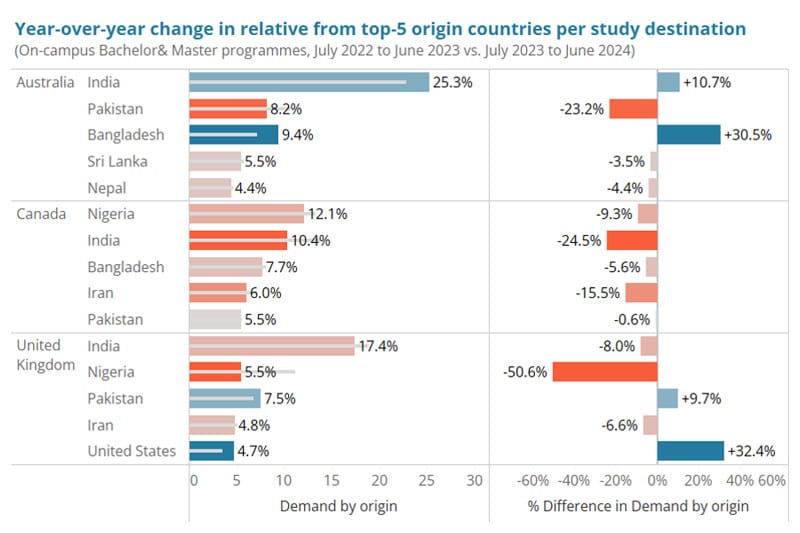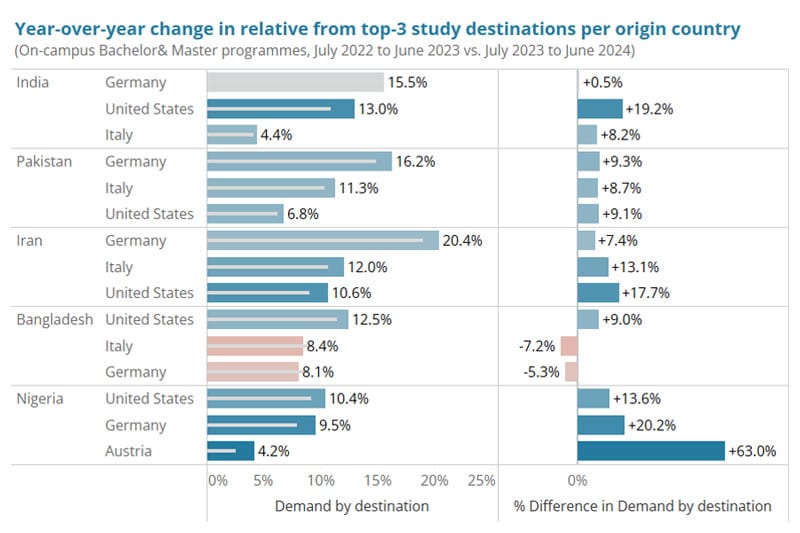Studyportals has shared new research on LinkedIn showing that many prospective international students are setting their sights on destinations other than Australia, Canada, and the UK due to immigration policies in those countries that make it less possible and/or attractive to study there.
The Studyportals research appears in an article entitled “Winners & Losers: An update on how domestic policies in the UK, Canada, and Australia have impacted student search behaviour,” and it is based on surveys that aggregate weekly pageview data across all Studyportals websites throughout 2024. This data highlights how several destinations are faring in terms of student interest since the policy changes took effect in Australia, Canada, and the UK.
The article drills down to regional-level data for each destination and looks at student demand by country of origin, offering real-time insights into how students in key markets are responding to policy changes.
Trendlines paint a vivid picture
According to the research, demand from prospective students for on-campus bachelor or master programmes offered in Canada and the UK was rising in January 2024, but then began to nosedive in February, especially for Canada. Declines accelerated in March 2024 then stabilised briefly, but the overall trend over February-July 2024 was downward.
Australia’s popularity over this period was much lower than the UK’s or Canada’s, but the trendline was less jagged. As the figure below illustrates, compared to the first week of 2024, the UK, Australia, and Canada respectively saw drops of 25.8%, 25.1%, and 17.6% by 21 July 2024.

Will the UK see a sustained bounce in demand given a new government?
While the graphic illustrates a marked loss of student interest in these destinations over the year, the article also notes that the UK has witnessed a very recent uptick in demand, which Studyportals suggests may be due to optimism over the result of the UK elections.
The previous administration under Rishi Sunak was responsible for the removal of most dependants’ right to accompany international students to the UK and actively contemplated a restriction of the Graduate Route, which provides two-to-three years’ of work rights for international students. There is now hope among international education stakeholders in the UK and international students that the new Labour government may reverse the restrictive course of the previous government. Speaking with Indian Express, Professor Manuel Barcia, Dean of Global Engagement, University of Leeds, said that:
“Based on the signals made by the incoming government prior to the election, we can reasonably speculate that the new government will work closely with universities in an effort to rectify years of neglect under previous administrations. The new Education Secretary, Bridget Phillipson, is already on record saying this much.”
Regional insights
The year-over-year change in international student demand also reveals key findings at the regional level for each destination. In the UK, institutions based in England saw only a slight decline in student demand in the last 12 months (July 2023 to June 2024) compared to the previous 12 months (July 2022 to June 2023). Meanwhile, institutions in Scotland and Wales saw increases in demand during the same period.
Elsewhere, key subnational regions in Canada and Australia registered significant drops in international student demand. In Canada, the provinces of Saskatchewan, British Columbia, and Quebec each experienced large declines while the states of South Australia, Western Australian, and Victoria also registered decreased demand. Only Alberta in Canada and New South Wales and the Northern Territory in Australia saw any significant increase in pageviews.
Shifting demand by origin country
Look closely at the data, and you’ll see variations in how demand for the UK, Canada, and Australia has shifted by source country. Canada, for example, has experienced a consistent decline in demand from each of its top five student markets, most notably from India (-24.5%) and Iran (-15.5%).
The story is similar for the UK, though the data offers a couple of bright spots. Nigerian demand for study in the UK has dropped significantly, falling by about half. At the same time, pageviews are up for the United States (32.4%) and Pakistan (9.7%).
Australia has witnessed a clear drop in demand from Pakistan, and less dramatic decreases from Sri Lanka and Nepal. On the other hand, Australia has benefited from a surge in demand from Bangladesh (30.5%) and to a lesser extent, India (10.7%).

Demand grows for other destinations
As increasing numbers of prospective students turn away from Australia, Canada, and the UK, which destinations are they exploring for study abroad?
The data reveals a few interesting trends. On-campus bachelor and master’s US programmes witnessed a rise in student demand from each origin country in the last 12 months. In Europe, Italy and Germany are gaining traction as alternative destinations in Europe, as the figure below makes clear.
It is important, however, to look at the granular data when considering trendlines. While Bangladeshi students also consider Italy and Germany, the data notes a drop in pageviews over the past 12 months compared to the previous 12 months. The United States saw a notable rise in demand from Indian students. In the case of Nigeria, Austrian institutions offer an appealing European alternative. Germany and the United States also saw increased interest from Nigerian students during this period.

Key takeaways
The Studyportals data suggests that immigration policies in Australia, Canada, and the UK are reshaping international student mobility in 2024 and leading into 2025. The UK may be in the midst of a modest recovery in student demand due to recent political changes, but that’s not the story in Canada and Australia, as both countries continue to experience pronounced declines in popularity.
At the same time, as the article suggests, the US – and European countries like Italy and Germany – have emerged as fresh alternatives for students from key markets in South Asia, Iran, and Nigeria.
A significant reduction in Nigerian and Indian students choosing Canada or the UK will be difficult for many institutions in those countries to adjust to. Consider that:
- Indian students composed more than 40% of Canada’s international student population in 2023, and Nigerian students accounted for 5%. If we add Iran (2%) – another declining market for Canada according to the Studyportals data – those three countries represented almost half of Canada’s international student population in 2023.
- Indian students made up 23% of all international students in the UK in 2022/23, and Nigerian students were 10% of the total. This means that a third of students in UK universities were either Nigerian or Indian in the 2022/23 academic year.
Canadian institutions may be particularly worried given that (1) they are more heavily reliant than UK universities on India and (2) demand from other top markets is also falling. The UK is at least seeing increases over 2024 from the US and Pakistan, its 4th and 5th largest student markets.
Overall, the research makes it abundantly clear that policy changes can quickly erode a destination’s competitive edge, and it suggests that students quickly respond by researching alternative destinations with more welcoming policies.
For additional background, please see:
Source